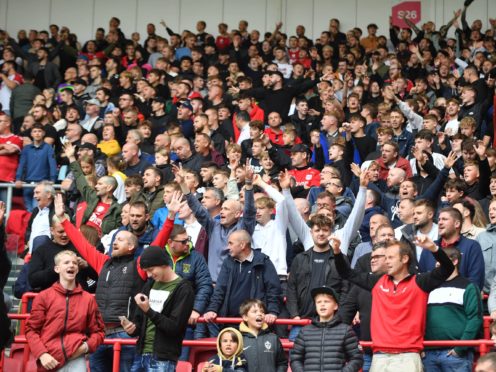Standing areas are set to be offered at selected Premier League and Championship grounds from January 1, ending a blanket ban on standing in the top two tiers of English football which has lasted for more than 25 years.
Clubs subject to the Government’s all-seater policy will be invited to apply to join an ‘early adopter’ scheme by October 6, the Sports Grounds Safety Authority said.
Safe standing trials will then run at the approved clubs from New Year’s Day 2022 until the end of the current season.
Chelsea, Liverpool, Manchester City, Manchester United, Tottenham and Wolves are among the top-flight clubs to have installed rail seating at their grounds.
Football grounds subject to all-seater policy invited to apply to have licensed standing areas from 1 Jan. Grounds must meet a range of criteria to be an early adopter, including having seats with barriers/independent barriers in home and away sections. https://t.co/SJzdMr6sfR pic.twitter.com/yNNxvUYj1D
— Sports Grounds Safety Authority (@SGSA_UK) September 22, 2021
Spurs and Manchester City are understood to be keen to be part of the pilot, and Liverpool said in June they were keen to trial temporary rail seating and then review it at the end of the campaign.
Championship club Cardiff said following the announcement of safe standing trials that they were installing seats with independent barriers in one area of their ground with a view to offering supporters a standing option this season.
The Football Supporters’ Association, which has campaigned in favour of safe standing for more than 30 years, described it as a “huge day” for match-going fans.
Standing areas in what is now the Premier League and Championship were outlawed by legislation passed in the wake of the 1989 Hillsborough disaster, which led to the deaths of 97 Liverpool fans.
Pete Daykin, the co-ordinator of the FSA’s Safe Standing campaign, described the news as “an outbreak of common sense”, and added: “It brings to an end a farcical situation in which fans at every ground continue to stand in their thousands – often to the detriment of those who can’t or don’t want to stand behind them – but that clubs can’t officially recognise or tackle in a constructive, proactive way.
“It also rights a historical wrong, breaking once and for all any suggestion of a link between ordinary football fans who prefer to stand and criminals, troublemakers and hooligans.
“It sounds preposterous to be saying it in 2021, but this was for so long the view of many of those in charge of running the game and the country, who neither understood football nor took the time to get to know its supporters. Today is a huge day for match-going fans.”
After 32 years, it's victory for the #Safestanding campaign! Today @SGSA_UK confirmed that clubs can apply to be early adopters and introducing standing areas in the top two divisions in England from January 2022 https://t.co/rgd95ni0F1
— The FSA (@WeAreTheFSA) September 22, 2021
Margaret Aspinall, whose son James died in the Hillsborough disaster and is the former chair of the disbanded Hillsborough Family Support Group, gave the news a cautious welcome.
“My opinion has completely changed from what it was a few years ago,” she told the PA news agency.
“Safety is paramount, and I hope lessons have been learned. Fans will not be treated, and are not being treated now, like they were in the 1970s and 1980s, herded like cattle.
“Things have changed and we have got to move on with the times. And the times are that the younger ones especially and some of the older generation do like standing, but there needs to be a seat for everyone, that is so important.
“We have got to take this slowly – there is no quick fix and we have got to make sure it’s definitely going to be safe and see how it progresses.

“The priority is the fans and their safety. As long as it’s monitored it should be OK.”
The introduction of the licensed standing areas follows a commitment by the Government in its 2019 General Election manifesto, and it is a move which has cross-party support.
Sports minister Nigel Huddleston said: “We have been clear that we will work with fans and clubs towards introducing safe standing at football grounds providing there was evidence that installing seating with barriers would have a positive impact on crowd safety.
“With independent research now complete, and capacity crowds back at grounds across the country, now is the right time to make progress. I look forward to hearing from clubs who wish to be part of our early adopters programme during the second half of this season.”
